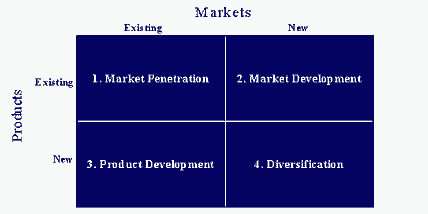How can we grow our business? How can we increase sales? How can we maintain or lower expenses?
If you're in business, you hear these questions almost daily. If you're in marketing, you have the authority and responsibility to address all of them.
For example, most marketers today are interested in campaign ROI, lead generation, and pipeline support and marketing costs as a percent of revenue.
It's axiomatic that businesses want to increase their top line (revenue) or decrease their middle line (expenses), often at the same time. The million-dollar question is how to do it.
Given entrenched competitors and charging upstarts, shorter product cycles and rapid commoditization, where can a company increase its chances of capturing incremental revenue profitably?
If we go back to a classic marketing framework, the Ansoff Matrix (see below, adapted from “Strategies for Diversification,” Harvard Business Review, September-October, 1957, p.114), we can discover a way to reliably segment revenues in terms of probability of capture (see The Channel Advantage by L. Friedman and T. Furey for additional discussion).
Revenue Segmentation
In a nutshell, revenue segmentation states that certain revenues have a higher probability of being captured than other revenues. For example, it is generally easier to cross- and up-sell (i.e., further penetrate) an existing customer than to initially penetrate a new customer. It's generally easier to sell established, tried-and-tested products than new and untested products. If we look at the Ansoff matrix, we have a useful method of ranking the probability of revenue capture.
Market Penetration
The most probable way to capture incremental revenue is to sell additional existing products or services to existing customers, which is a strong reason to make sure your current customers are highly satisfied.
Most companies have a lot of “running room” before they own 100% of the addressable spend of their clients. For example, one of your clients may spend 10 million a year on technology services, and your company may account for only 2 million or 20% of their spend (often termed “wallet share”), even though it's one of your largest accounts.
By conducting a thorough needs analysis around your customers' use of your products or services, and by understanding how you might be able to bundle additional products or services at a lower cost (e.g., solution focus versus product sale), you can begin to better identify, target and penetrate the most probable revenues to be had.
Market Development
The second-most probable way to capture incremental revenue is to sell tried, tested, proven and productive products or services into new markets. These new markets may be geographies, segments, verticals or some combination of the three. For example, in the vertical space, if you already sell one of your solutions to Microsoft and it is a referenceable client that is getting value from your products or services, it's likely that you will have a good chance of selling the same solution to similar software companies.
I realize that this idea is not revolutionary, but when you evaluate how Sales and Marketing are spending their time, the overall matrix can help you to increase the odds of capturing incremental revenue by applying the requisite resources to higher-probability opportunities.
Product Development
The third-most probable way to capture incremental revenue is to sell new products into your existing market base. By better understanding the market penetration piece, and by asking your clients about all the complements and cascading events that happen when they implement/use your product or service, you can better understand what new offerings can add value to your clients.
For example, under Jack Welch, General Electric was able to capture a significant amount of incremental revenue by better understanding the service wrap around their products and then capturing that part of the business.
Diversification
This strategy is probably the most risky. In terms of going into new markets with new products, many companies will mitigate risk by buying into a market through an acquisition or creating a strategic alliance or partnership as a way to leverage other companies' relationships, expertise, or customer base.
The risk-mitigating methods help to make a “cold” sell a little warmer by either buying or bonding with some other firm's existing markets, products, or both. If you are thinking of pursuing a diversification strategy, you should prevent or mitigate risk as much as possible—while making sure the risk is justified, given the reward.
Integrative Questions
- Where are you placing your bets in terms of sales and marketing time and resources?
- Do the probability ranks described above seem to hold up when you look at your win or close rates?
- How can you bond (i.e., alliance/partnership) or buy your way into existing/new markets or products?
- What can you do more or less of to increase the probability of capturing incremental revenue?
- How can you better manage risks and resources in pursuing less-probable revenues?
Conclusion
The Ansoff matrix is not only a useful framework for plotting a company's growth strategy but also a valuable tool for better understanding the probability of capturing incremental revenue through a particular product, market or customer strategy.
Some people use the term “farmers and hunters” when they think of salespeople; the former are more likely to sell into the existing market or customer base, while the latter are more likely to go after new markets and customers. Although both roles are important to the firm, they need to be assessed in light of probable revenue capture. For example, in hunter-gatherer times the majority of the caloric intake was due to the efforts of the women, who gathered, rather than that of the men, who hunted.
The majority of a company's revenue is likely to come from its existing customer base, although it's clear that a company also needs to continually add to its customer base, as some customers will lifecycle-out or defect.
As Damon Runyon said, “The race is not always to the swift, nor the battle to the strong, but that's the way to bet.”





